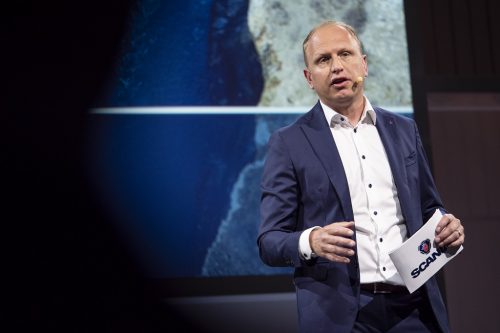
Scania study says fossil-free commercial transport is achievable within Paris Agreement target
FRANCE A fossil-free commercial transport system in the timeframe of the Paris Agreement target is not only possible, but also financially attractive from a societal perspective. This is the key conclusion of a study initiated by Scania.
The Paris Agreement was signed in 2016 and is within the United Nations Framework Convention on Climate Change dealing with greenhouse gas emissions mitigation, adaption, and finance starting in 2020.
“Reaching zero CO2 emissions in our sector in the timeframe of the Paris Agreement is attainable but will call for change at an unprecedented high speed, and for serious and joint private and public sector commitment,” said Henrik Henriksson, Scania’s President and CEO.
A comprehensive analysis undertaken by Scania, and reviewed by an external academic panel, shows that several pathways can be pursued to phase out carbon emissions.
Tracing the road to zero emissions by 2050 through a back-cast modelling approach, the analysis shows the viability of concurrent pathways. The research covers three transport segments: long haulage, distribution and city bus, and four countries: Sweden, Germany, China and the US.
“We can achieve more than 20% reduction of CO2 emissions by working even smarter in the current transport systems, for example through improved routing and better load management,” he continued.
“On top of that, we see several fuel and powertrain pathways to a fossil-free future. Biofuels offer the fastest CO2 emissions reductions and electrification is the most cost-effective.”
New technologies can take a long time to achieve wide adoption, as the existing stock of vehicles turns over slowly. To be fossil-free by 2050 therefore requires, changes at scale already by 2025, including not only new technologies but also new infrastructure.
Further, we need to achieve an average global growth rate of new fossil-free powertrain technologies of at least 5 to 10% per year and achieve full sales penetration by 2040. To reach this goal, the transport sector and adjacent industries must initiate change rapidly and immediately.
These are the key conclusions of The Pathways Study: Achieving fossil-free commercial transport by 2050:
- Smarter logistics: Carbon emissions can be cut by more than 20% by optimising systems, for example improving routing and load management. The remainder can be reached with alternative powertrains and fuels;
- Electrification: Battery electric vehicle growth constitutes the most efficient, quickest and cost-effective pathway in countries with the infrastructure potential to provide universal charging systems and non-fossil energy. Full-scale electrification will require significant infrastructure investment relative to the present situation. In return, operating expenses are 40% lower than for heavy diesel vehicles. Electric highways for long-haulage transportation can accelerate electrification, particularly in the coming decade when the cost of battery costs is expected to remain high;
- Biofuel: Biofuels will initially offer an effective and viable pathway, taking advantage of traditional combustion engine technology. The technology and fuels are both available here and now. With maximum possible use of globally available biofuel supply, biofuel-based combustion engines can power one-fifth of vehicles in 2050; and
- Fuel Cells: Since fuel cell vehicles will be more expensive, substantial growth for this pathway is expected to be later than for battery electric vehicles. If cost of technology decreases and renewable hydrogen is available and plentiful at low cost, by 2050, fuel cell can be a substantial part of the vehicle fleet.
Although the study noted differences in the coming 15 years, the pathways are relatively similar over time and across the varying markets.
Regardless of pathway, or if it will be a mix where multiple powertrain technologies and infrastructures coexist, they require not only an unprecedented rate of technological change but also that of adjacent industries to decarbonise.
Starting immediately, funding mechanisms and firm commitments must be made available for large-scale technological and supporting infrastructure development.
The energy system, globally, must in parallel phase out fossil-fuel dependency. Equally decisive is that transport buyers continue to increase the demand for fossil-free supply and delivery services.
Based on the findings from The Pathways Study, a coalition of companies has been formed. E.ON, H&M Group, Scania and Siemens have come together and have invited others to join them.
“It is a stepping stone for further and deeper knowledge about the global decarbonisation of heavy commercial transport,” said Ulf Troedsson, President and CEO of Siemens Nordics. “However, it is already now clear that infrastructure for electrification of heavy vehicles is a key part of this journey. It is therefore a very good fit for Siemens to join the group of companies willing to influence and commit to making this happen.”
“There is no doubt that green energy will power the transport system of the future,” said Marc Hoffmann CEO of E.ON Sweden. “The transformation of the heavy commercial transport sector impacts a full ecosystem of players. When we look at our long-term agendas, we are aligned, but it is now that we need to join forces to catalyse change. This is only the first step in a very interesting collaboration.”
“Climate is one of the most important priorities for any company today and we have set high ambitions for our business to become climate positive by 2040,” said Anna Gedda, Head of Sustainability H&M group.
“But it is only when we join forces with other key players in the industry that we can achieve ambitious goals.”

